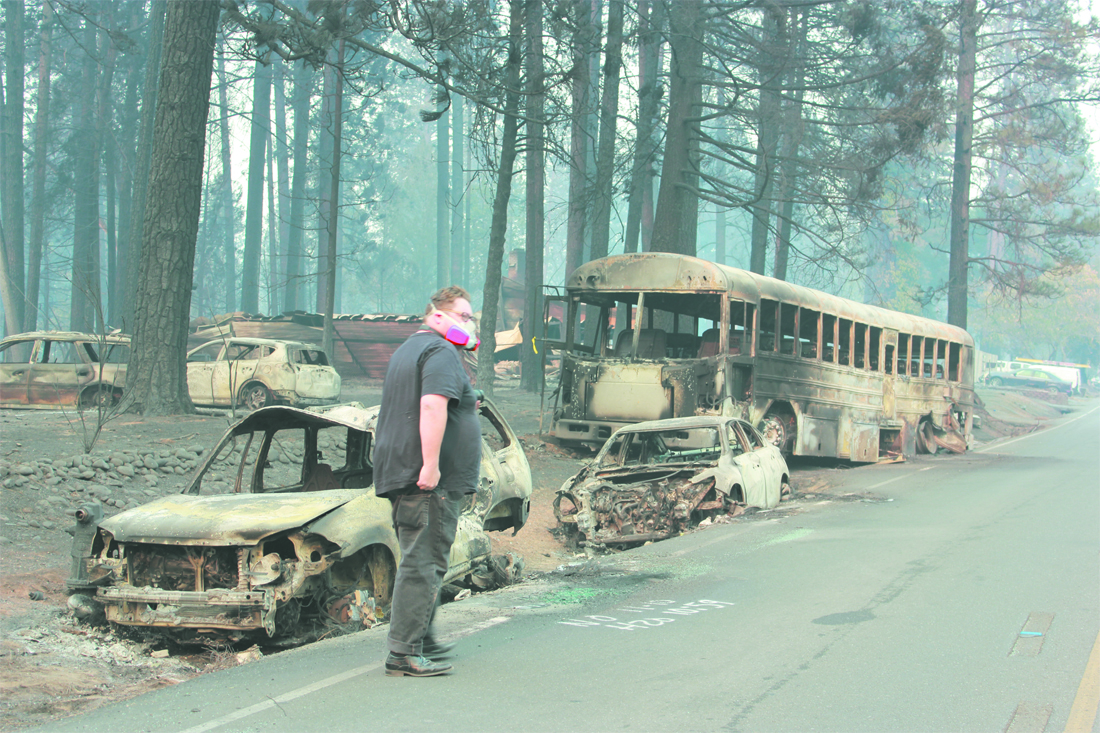
Photo by Melissa Daugherty
CN&R contributor Ken Smith positions himself to take photos of the charred husks of cars on the Skyway.
On a dark and smoky morning in July 2018, a friend and I wheeled past a National Guardsman manning a Humvee-mounted machine gun at the last of a series of roadblocks standing at Redding’s western edge, and into the footprint of the then-active Carr Fire.
Our mission that day was both professional and deeply personal.
We’re both journalists, and both grew up on the rural outskirts of Redding—some of the areas most affected by that terrible fire, which burned nearly 230,000 acres, more than 1,000 homes and took eight lives. Our press credentials came courtesy of my hometown newspaper, the Shasta Lake Bulletin, and en route from Chico we met his parents at the Corning casino they’d evacuated to. His dad asked us to see if their home and a half-dozen other family properties survived, and his mom cried every time she reminded us to check on her chickens.
Past the checkpoint, wide swaths of formerly forested areas had been wiped away and replaced with a blanket of still-smoldering ash, while in other places whole, charred trees—torn from the ground by the fire’s record-setting localized winds (and resulting “firenado”)—littered roadways alongside live power lines. The devastation was even more profound as we came back toward the city on the north side—through the now-incinerated community of Keswick and into the ruins of neighborhoods where I’d attended family barbecues and high school parties.
At the end of the day, we were about 50/50 on the properties we checked on, and my companion’s childhood home (and its resident chickens) made it. Miraculously, it seemed, as the ground around the house and coop was covered in charred pockmarks caused by falling embers, and the fire stopped yards from the front door. My own family’s homes also made it through safely, with the only direct damage more symbolic than physical—flames ripped through the Whiskeytown Cemetery, turning a sapling that had sprung from my mother’s grave to charcoal and leaving her headstone covered in ash and soot.
I hoped to never see destruction like that firsthand again, but it was far eclipsed in scale, proximity and personal impact a few months later by the Camp Fire. I’d left my job at the CN&R earlier that year to pursue a freelance career, but with the community in crisis I felt helpless and was driven—like many other people—to contribute the best way I knew how. In my case, that meant reporting, and I was happy to rejoin my colleagues at this paper.
I remember the days following the fire as a blur of activity and anxiety. During the day I dashed between shelters, makeshift settlements, community meetings, the incident command center and the broken Ridge. At night there were more meetings, time spent with friends who’d lost everything, getting to know my new roommate (a displaced survivor), and watching Butte County Sheriff Kory Honea deliver the daily toll of the missing and confirmed dead.
I didn’t have time to process my own experience until I traveled to Santa Rosa for Thanksgiving, as the fire still burned. The rain that helped quell the inferno started falling just as I left Chico, and I was overcome with emotion at the weight of it all.
Those feelings returned as I passed through Middletown, still visibly scarred from the 2015 Valley Fire, and other areas affected by that summer’s Mendocino Complex Fire. The reality of recovery sank in in Santa Rosa, where little had been rebuilt in the footprint of the 2017 Tubbs Fire and survivors detailed how their community had changed. Lack of housing, an insane real estate market, a mass exodus of residents—all the things they mentioned and more have come to pass in Butte County.
I am sometimes haunted by things I saw during the Camp Fire, and the trauma of it all still hangs heavy over our community. But perhaps more troubling is the realization that other California communities share some of that pain, and the surety that still more will in the future.
